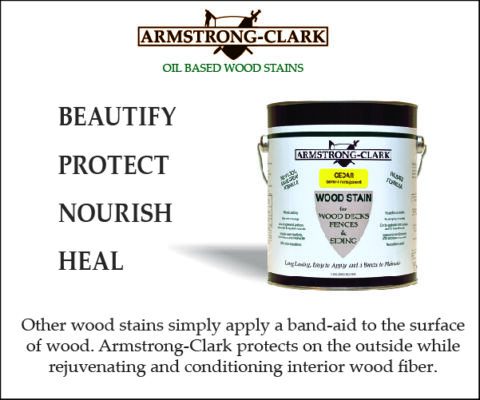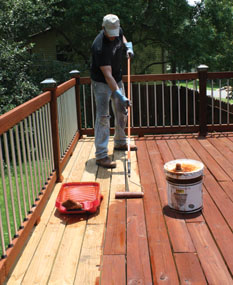what to use to seal wood for outdoors
Staining and sealing outdoor woods is among the all-time ways to protect it from the elements.
Past Matt Weber
Whether information technology's pressure-treated, cedar, cypress, redwood or even a loftier-end exotic hardwood, the right intendance and maintenance volition protect exterior wood and keep it in good shape for years. Staining and sealing outdoor wood is amidst the best ways to protect it from the elements.
Know Your Coatings
The most common outdoor wood coating is an exterior-grade penetrating stain. These water-repellent preservatives include a mildewcide, and some products contain ultraviolet lite absorbers that protect from lord's day exposure. Bachelor in both oil- and water-based formulations, the resins penetrate wood pores to provide pigment and block out the dissentious outcome of atmospheric condition while allowing the natural woodgrain and texture to shine through.

The second category is a picture show-forming sealant that bonds to the surface of the wood like pigment or shellac. These products provide a high-gloss article of furniture look, while still allowing the natural grain to show through. Available in oil- or h2o-based finishes, they form a durable cute, satin surface, but they tin can only be maintained with another glaze of film-forming sealant. Pigments are added to alter the wood color and add together UV protection. Film-forming sealants should be avoided in areas exposed to foot traffic, because the abrasion can wear through the film blanket.
Outdoor wood coatings are typically formulated with either h2o or oil. Virtually water-based stain/sealants have tiny particles of pigment and resin that attach to each other very tightly as the finish dries, similar to a patchwork quilt. With oil-based finishes, the tiny particles actually fuse together chemically into 1 large sheet-like substance, which achieves a harder finish and is less likely to develop an bister colour tone. Examine the production'south label for clues to the coating'south quality, looking for any reference to "non-yellowing" backdrop.
H2o-based finishes are generally heralded for their ease of use. Compared to oil-based formulas, they're easier to clean up, have a lower odor and are often less expensive. However, well-nigh h2o-based coatings require more coats and still don't final as long as their oil-based or "alkyd" counterparts, which generally provide more long-term, wood-preserving durability.
New Wood
Let new pressure level-treated wood to dry before staining or sealing. The treatment of lumber with waterborne preservatives leaves moisture in the wood.
This is why fresh PT lumber ofttimes arrives wet from the supplier, and the moisture tin can impede the penetration of stains and paints. For best performance of paint and stain coatings, let the treated wood to dry for 2 to four weeks prior to application. Estimating exactly how long treated wood will accept to dry out is difficult, and a lot depends on how much fourth dimension has elapsed since the treatment, the lumber'south exposure to the sun, ambient weather condition, etc.

Woods with natural preservatives, such as Western Red Cedar, cypress and redwood, exercise not require as much drying fourth dimension because the wood was never pressure-treated with a preservative.
Contrary to popular conventionalities, new woods notwithstanding needs to be cleaned to remove any "mill scale", which is a compression of the grain during the milling process that can cause the stain to float or run off without absorption. Clean the surface with an oxygenated bleach.
Weathered Wood
When woods is exposed to the sunlight the ultraviolet rays tin can impairment the forest fibers over time, causing the surface to turn greyness. The well-nigh direct style to renew the appearance is to sand or force per unit area-wash the surface. However, sanding can exist very hard and time-consuming, and pressure-washing can remove the gray but crusade the surface to fuzz or splinter, posing a "touch" gamble for areas such equally deck surfaces where people may walk barefoot. When using a power-washer, limit your force per unit area to no more than than one,000 or 1,200 PSI.
Some individual lath may be heavily weathered. Supercede them completely, clean the existing boards, and then stain them all to match.
Wood with Sometime Stain
In full general it's best to remove old stain before applying new stain, especially if changing products or colors. Old stain will usually show through the new stain, leaving blotchy spots in the finish. "Film-forming" stains must exist completely removed before applying a penetrating stain. However, if you plan to stick with the same color and blazon of stain (and your deck is in decent condition) and then yous can probably get by with a thorough cleaning and a fresh maintenance coat. As always, refer to the manufacturer'southward recommendations for best practices.
If there is a buildup of old stains on the deck, and so you may need to remove information technology with something stronger than an oxygen bleach cleaner. Stain strippers are more caustic, but they remove most weathered stains in a single application. Small, stubborn spots of stain can and so be removed with a hand sander once the deck has dried.
Conditioning
An often disregarded step for outdoor staining projects is the application of a wood brightener. These chemical agents open the woodgrain to improve penetration of the stain and aid restore the appearance of weathered wood to a like-new condition. The product can simply be sprayed onto the wood surface, given a few minutes to piece of work its "magic" and then rinsed off, requiring very little labor.
After using any chemical treatment to clean and fix the wood, use plenty of water to completely remove all traces of the products—and and so allow it to dry prior to stain or sealer application.

Awarding
Always thoroughly mix the stain to evenly blend the solids and ensure a consistent color tone throughout the project.
For both horizontal and vertical structures, brushing is the best method for stain/sealer application considering the bristles button the product evenly into the woodgrain to increase absorption. Using a sprayer or roller can apply the stain more speedily, merely both of these methods go out much of the stain on the surface without adequate penetration into the pores. This superficial product can wear away unevenly, so you should yet dorsum-brush it into the woodgrain for the most consequent appearance and best protection.
For more info contact, Armstrong Clark Wood Stains armclark.com
Source: https://extremehowto.com/preserving-outdoor-wood/
Enregistrer un commentaire for "what to use to seal wood for outdoors"